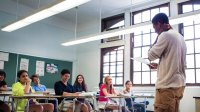Enduring Practices From Remote Teaching
After a yearlong crash course in digital tools and remote teaching, a teacher reflects on what will stick in her brick-and-mortar classroom.
Your content has been saved!
Go to My Saved Content.For some students, virtual school has been a boon: They feel less anxious, have more quiet time to work and reflect, and feel empowered to design their own schedules. Online learning has freed students to contribute their voices in new ways and has improved teachers’ efficiency by transforming previously dead time—when students are waiting for the teacher to introduce the next learning task—into time in which students can exercise increased freedom and choice.
Going forward, here’s how I plan to harness virtual school observations to support more differentiated instruction and increased student agency.
Rethink the Daily Agenda
A virtual agenda, inspired by my colleague, has become a cornerstone resource in my English classrooms, and its benefits have persuaded me to keep it around when we return to in-person learning.
Instead of a static daily agenda written on the board, create a digital agenda for the unit that includes each day’s lesson outline, relevant hyperlinks, the rationale for each activity, and homework. Practice the routine of accessing and following the agenda each day in class, and remind students to refer to it at home to avoid that sinking “Wait, what did we do today?” feeling.
A living agenda—one that is updated every day—supports self-paced learning, allowing students to move on when they are ready, rather than waiting for everyone else to finish. Moreover, because a virtual agenda allows streamlined access to all unit materials, students can see clearly how their learning builds. It also supports conferencing, allowing teachers to refer students to previous materials to help them fill gaps or to offer a refresher of a lesson from weeks earlier.
Re-create the Chat
We have learned how to use the Zoom chat to engage and hear from quieter students, assess understanding, solicit quick feedback, and check in one-on-one. These powerful modes of communication and connection underscore the need to make space in our physical classrooms for back-channel engagement.
Using tools like Mentimeter or Google Docs, or even chart paper and whiteboards (bonus if kids must move in order to join the conversation), make it routine for students to engage nonverbally with the material and their classmates. Ask students to respond to others’ ideas during or after discussion, synthesize lesson concepts after direct instruction, or echo important moments or beautiful language from their reading.
If more students want to contribute to discussion than time allows, use the chat space as a parking lot to capture ideas you’ll return to later.
Build In and Leverage Mindful Breaks
Remote learning has made breaks nonnegotiable, and there’s no reason why we should abandon those benefits simply because of a change in environments.
Make breaks a given, especially for longer instructional blocks, and vary preplanned synchronous breaks with providing students a choice of when to take their break. Review and practice break norms (avoid breaks in the first 20 minutes of class, for instance), and assign accountability tasks to complete before or after a break.
If some lessons don’t lend themselves to student-selected break times, transition back from a group break by building community, perhaps asking students get-to-know-you questions or playing a brief round of content-specific trivia, or ask students to report back from their accountability task as you transition into the lesson’s next segment.
A break during class opens up possibilities for teachers too: Check work to catch misunderstandings, review submitted homework to form readiness groupings, or pause to reflect on the lesson so far and adjust for the next class. Or, take an actual break with the students, modeling screen-free mindfulness.
Split Whole-Group Discussions in Half
Student-driven, full-group discussion centered on shared texts is an English classroom staple. Zoom breakout rooms have presented an opportunity to break the class in half; discussions have become more intimate, with more room for students to speak multiple times as the conversation gains momentum—and less room to hide if they aren’t prepared.
When you return to physical classrooms, assign half of the class a quiet, independent task to complete while the other half engages in discussion; then switch. Perhaps allow some non-discussing students to locate a quiet spot outside if they find the other group distracting (and equip them with a clear deliverable task and a timer), or offer the non-discussion group the option to use headphones to focus on their work so that any neighboring discussion is in the background.
Solicit Student Feedback
Remote learning has found many teachers eager to know what’s going on behind those small squares of students on their screens. In online learning contexts, more frequent solicitation of student feedback on learning pace, methods and modality, and homework load has proven critical to supporting both learning and students’ mental health. This feedback can be gathered through surveys, as well as informal check-ins and polls. What better way to send the message that we value students’ agency in our classrooms than by asking them how it’s going, regardless of the learning context?
Use students’ survey responses to help guide instruction both during and after a unit. Whether you are virtual or in person, these surveys underscore that you and students are partners in this invigorating but unpredictable journey that we call learning.
